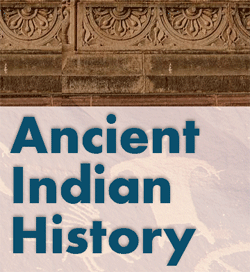IAS Prelims: General Studies (Ancient Indian History) - Pre-Mauryan Age 6th – 4th Century BC
Ancient Indian History
Pre- Mauryan Age (6th – 4th Century BC)
Punch-marked coins: The rise of the Mahajanapadas in the 6th century BC alongwith agricultural surplus, and the rise of arts and crafts which facilitated trade and commerce led to the appearance of coins for the first time in the pre-Mauryan.
Archaeological Remains
(i) Many urban centres such as indraprastha, hastinapura, shravasti, Varanasi,
rajagriha, champa on the banks of rivers in north india.
(ii) Northern black polished ware (NBPW) type of pottery was the characteristic
feature of this age.
(iii) Iron use increased in this period.
(iv) Mud bricks were used for the construction of cities.
(v) Punch- marked coins were used to facilitate trade and commerce.
Brahmanical Literature
It consisted of the ‘Vedangas’ or the limbs of the Vedas whose study was necessary to understand the Vedas properly. The vedangas were written in the form of ‘Sutras’ i.e. condensed prose style intended for memorization there are six vedangas: (a) Shiksha (Phonetics), (b) Kalpa (rituals), (c) vyakarana (grammer), (d) Nirukta (etymology), (e) Chandas (metrics) (f) Jyotisha (astronomy, not Astrology).
The kalpa sutras are divided into three classes:
(i) Srautasutras - concerned with rituals of great scarifies
of Agni, soma, animals. The sulvasutras, which are the oldest books on Indian
geometry are part of the Srautasutras.
(ii) Grihyasutras - concerned with the domestic ceremonies and
sacrifices to be performed by the householder.
(iii) Dharmasutras - concerned with the legal aspects of life
and are foundation for the dharmasastras such as the laws of manu.
Four minor Vedas called ‘Upavedas’ came to be written on the basis of the
vedic literature. They are:
(i) Ayurveda – concerned with medicine
(ii) Slip Veda- concerned with sculpture
(iii) Gandharva Veda- concerned with music
(iv) Dhanur Veda- concerned with warfare
- Buddhist Literature: It consists of the pali canon in the form of three pitakas Suttapitaka, Vinayapitaka , Abhidammapitaka
- Suttapitaka: It consists of the speeches and messages of the Buddha.It wa composed by ananda in the first Buddhist council at Rajagriha in 483 BC
- Vinayapitaka: It consists of the monastic code with rules of behavior for the monks an nuns of the Sangha. It was composed by Upali in the 1st Buddhist council at rajagriha in 483 BC.
- Abhidhammapitaka: It is a compilation of philosophical sayings. It was composed by Mogaliputta Tissa (Upagupta) in the 3rd Buddhist council at Pataliputra in 250 BC.
- Jain Literature: It was written in prakrit. Earlier jain literature was a set of 14 books called Purvas. They are now lost 12 Angas were written ,on the basis of 14 purvas.
Foreign Authors
(1) Herodotus wrote ‘Historica’. It talks about trade relations of india
with Persia.
(2) Aristobolus wrote ‘History of the war’. He came to india along with
Alexander.
data-matched-content-ui-type="image_card_stacked"
Useful Tips & Articles
तैयारी कैसे करें? |
EXAM SUBJECTS |
STUDY RESOURCESDownload Free eBooks |


